A pattern is made of series of impulses and corrections where the trend is maintained, such as in the 8 wave cycle where the first 5 waves are a trend and the last 3 waves are a correction that is against the trend. To state it in a simpler way, all impulses within a pattern must be in the same direction; an 8 wave cycle is thus made of two patterns.
Why is it important to know a pattern from a cycle? Because in Elliott methodology, there are rules and observations that apply strictly within a pattern; the rule of alternance is an example that we will discuss later. Patterns are also fractal and many times, we will see a pattern referred to as a 5-3-5-3-5. It is a lot simpler than it looks, it means the first impulse is made of 5 waves; the next correction is made of 3 waves and so on so forth. Patterns are not always orderly as in the basic Elliott cycle, when the market starts consolidating (usually after a strong correction of the trend) triangle patterns will take place. Waves can also fail or change dramatically their range of volatility. When this happens, we get erratic wave counts and the trend is almost flat.
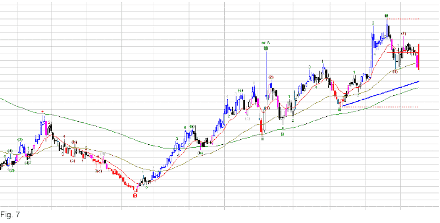
The above chart displays many patterns and cycles most embedded in a larger cycle. Remembering that the circled numbers are the largest cycle, we look at the red circled 5. This is the point where wave 5 of 34% sensitivity ended; it is the end of the bearish pattern and a large correction starts. It is so strong that after the wave A or 1, wave B is over within a few bars. We will use bars rather than days because the scale could be months, weeks, days or minutes as in intra day.
Within the A wave, we have smaller patterns in roman numbers, within those even smaller in bracketed numbers and lastly the smallest pattern in plain numbers. As we said before, patterns are not always perfect; our first note of this is within the wave A where the roman pattern is a 3 wave pattern. Normally an impulse is made of 5 sub waves; in corrective patterns, the smaller patterns adjust poorly because of the rapid change in volatility that makes the filter inadequate.
So here we are at the beginning of this trek and already things are falling apart; this trek is in a real market where only perceptions drive the price. So we need to adjust to changing conditions and how they affect our analysis and wave counting. Throughout this book, we will use real market examples and we will avoid textbook examples because we will seldom meet them in real life. Back to patterns, what kind of patterns will we see in the market? Typically patterns are sorted between impulse, zigzags, flats, triangles, diagonals, extensions and truncations.
Except for the first two, most of these patterns occur during corrections. The basic Elliott cycle is made of two patterns, the impulse for the first 5 waves and a zigzag for the last 3 waves. As we will endeavour trading impulses, we will brush rapidly over them (an impulse usually follows a correction hence the need to recognize them). As the impulse pattern is the one we have discussed since the start, we will go to the next one.
Zigzags
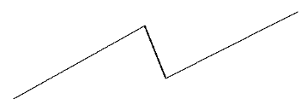
The zigzag is made of 2 impulse waves separated by a corrective wave and the whole pattern takes the price further in the direction of the trend.
Flats
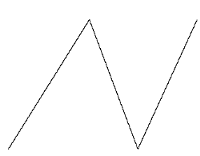
Flats are like a zigzag but do not really move the price further in the direction of the trend. After the first wave, the correction will retrace most of the wave and the third wave will just get back to the level of the first wave.
Triangles
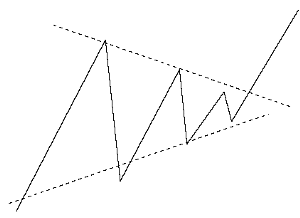
Triangles are made of 5 waves where each wave is smaller than the preceding. There are many types of triangles, ascending, descending, symmetrical and within the later expanding or contracting. What is important to remember from triangles is that they usually exit in the same direction they started.
Diagonals

Similar to triangles but both containment lines are heading in the same direction and the exit is in opposite direction from the trend. These take place mostly in wave 4 of an impulse or the C wave of a correction.
Extensions
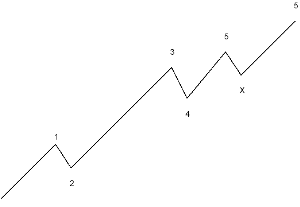
Extensions can develop in any of the impulse waves and many times the X wave will retrace into the previous peak or trough territory. AlphOmega tracks extensions by labelling the waves in the usual order and giving an X on the sixth and a 5 on the seventh; this is as long as the individual wave criteria are met.
Truncations
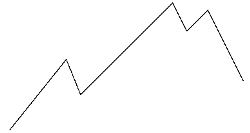
Truncations are literally a fifth wave failure since the peak or trough of wave five does not extend beyond the previous peak or trough. This is the most frequent failure. Note that AlphOmega reads this failure in its own way, up to wave 4 the labels are normal, and then at wave 5 failure it will reassess the count because it will see the wave as a 2 of the opposite trend (which reassesses the wave 4 as a 1 of opposite trend).
The label of wave 4 remains unchanged as up to that point the wave meets the criteria; the label of wave 5 will never display as its criteria is not met hence the label 2 of opposite trend. This is important to price and time projection as it will calculate from a different base.
Next: Other Type of Failure
Summary: Index